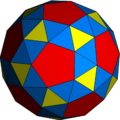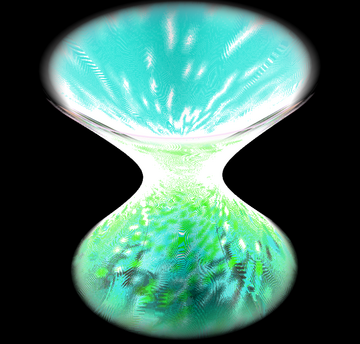Solid geometry or stereometry is the geometry of three-dimensional Euclidean space (3D space).[1] A solid figure is the region of 3D space bounded by a two-dimensional closed surface; for example, a solid ball consists of a sphere and its interior.
This article needs additional citations for verification. (May 2014) |

Solid geometry deals with the measurements of volumes of various solids, including pyramids, prisms (and other polyhedrons), cubes, cylinders, cones (and truncated cones).[2]
History
The Pythagoreans dealt with the regular solids, but the pyramid, prism, cone and cylinder were not studied until the Platonists. Eudoxus established their measurement, proving the pyramid and cone to have one-third the volume of a prism and cylinder on the same base and of the same height. He was probably also the discoverer of a proof that the volume enclosed by a sphere is proportional to the cube of its radius.[3]
Topics
Basic topics in solid geometry and stereometry include:
- incidence of planes and lines
- dihedral angle and solid angle
- the cube, cuboid, parallelepiped
- the tetrahedron and other pyramids
- prisms
- octahedron, dodecahedron, icosahedron
- cones and cylinders
- the sphere
- other quadrics: spheroid, ellipsoid, paraboloid and hyperboloids.
Advanced topics include:
- projective geometry of three dimensions (leading to a proof of Desargues' theorem by using an extra dimension)
- further polyhedra
- descriptive geometry.
List of solid figures
Whereas a sphere is the surface of a ball, for other solid figures it is sometimes ambiguous whether the term refers to the surface of the figure or the volume enclosed therein, notably for a cylinder.
| Figure | Definitions | Images |
|---|---|---|
| Parallelepiped |
|
 |
| Rhombohedron |
|
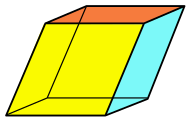 |
| Cuboid |
|
 |
| Polyhedron | Flat polygonal faces, straight edges and sharp corners or vertices | |
| Uniform polyhedron | Regular polygons as faces and is vertex-transitive (i.e., there is an isometry mapping any vertex onto any other) |
|
| Prism | A polyhedron comprising an n-sided polygonal base, a second base which is a translated copy (rigidly moved without rotation) of the first, and n other faces (necessarily all parallelograms) joining corresponding sides of the two bases | 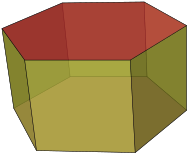 |
| Cone | Tapers smoothly from a flat base (frequently, though not necessarily, circular) to a point called the apex or vertex |  |
| Cylinder | Straight parallel sides and a circular or oval cross section |
|
| Ellipsoid | A surface that may be obtained from a sphere by deforming it by means of directional scalings, or more generally, of an affine transformation |  sphere (top, a=b=c=4), spheroid (bottom left, a=b=5, c=3), tri-axial ellipsoid (bottom right, a=4.5, b=6, c=3) |
| Lemon | A lens (or less than half of a circular arc) rotated about an axis passing through the endpoints of the lens (or arc)[6] |  |
| Hyperboloid | A surface that is generated by rotating a hyperbola around one of its principal axes | 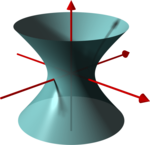 |
Techniques
Various techniques and tools are used in solid geometry. Among them, analytic geometry and vector techniques have a major impact by allowing the systematic use of linear equations and matrix algebra, which are important for higher dimensions.
Applications
A major application of solid geometry and stereometry is in 3D computer graphics.
See also
Notes
References
Wikiwand in your browser!
Seamless Wikipedia browsing. On steroids.
Every time you click a link to Wikipedia, Wiktionary or Wikiquote in your browser's search results, it will show the modern Wikiwand interface.
Wikiwand extension is a five stars, simple, with minimum permission required to keep your browsing private, safe and transparent.
 ...
...


